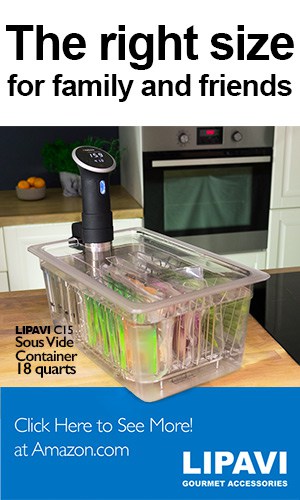-
Sous Vide Time and Temperatures
Sous Vide Time and Temps
Sous Vide Time and Temps
Sous Vide Temps
- All Sous Vide Temperatures
- Sous Vide Beef Temperatures
- Sous Vide Chicken Temperatures
- Sous Vide Duck Temperatures
- Sous Vide Fish Temperatures
- Sous Vide Vegetables Temperatures
- Sous Vide Infusions Temperatures
- Sous Vide Lamb Temperatures
- Sous Vide Pork Temperatures
- Sous Vide Shellfish Temperatures
- Sous Vide Turkey Temperatures
- Recipes Recipes Recipes Recipes
- Getting Started Guides Getting Started Guides Getting Started
- Equipment and Tools Equipment and Tools Equipment Equipment and Tools
- More Resources More Resources Resources More Resources
What is Calcium Lactate and How to Cook With It
More Modernist Ingredients
Click here to get great sous vide content via email
This post may contain affiliate links. Read more.
Written by Jason Logsdon
Calcium lactate is a calcium salt and is one of the most common ways to introduce calcium into mixtures. It is typically used with sodium alginate and other ingredients that require calcium.
Calcium lactate has a mild taste and can be used in both direct and reverse spherification.
Where to Buy Calcium Lactate
We always recommend ModernistPantry.com, they have great service and are really good to work with (because of this, we do have an affiliate relationship with them). We also recommend purchasing calcium lactate from WillPowder and get larger quantities and bundles at ForTheGourmet.com .
Calcium Lactate Recipes and Articles
Chipotle Caviar and Crispy Pulled Pork Recipe
 This recipe combines crispy pulled pork and savory deviled egg with a burst of spicy chipotle flavor into one of the more unique combinations. The crispy pulled pork can be used as a garnish for many dishes, and a topper for fish or salads.
This recipe combines crispy pulled pork and savory deviled egg with a burst of spicy chipotle flavor into one of the more unique combinations. The crispy pulled pork can be used as a garnish for many dishes, and a topper for fish or salads.
Melon Soup Spheres Recipe
 This recipe makes fresh cantaloupe and honeydew melons into a simple flavorful soup, then turns it into little spheres that my guests can pop into their mouths. By using a modernist spherification technique and the modernist ingredients of calcium lactate and sodium alginate, you too can make a fun take on this favorite summer food!
This recipe makes fresh cantaloupe and honeydew melons into a simple flavorful soup, then turns it into little spheres that my guests can pop into their mouths. By using a modernist spherification technique and the modernist ingredients of calcium lactate and sodium alginate, you too can make a fun take on this favorite summer food!
Chipotle Caviar Recipe
 Using miniature spheres, referred to as caviar, is a great way to add little bursts of flavor to dishes. Here we use a chipotle water but you can use the same technique on any liquid that doesn't contain calcium.
Using miniature spheres, referred to as caviar, is a great way to add little bursts of flavor to dishes. Here we use a chipotle water but you can use the same technique on any liquid that doesn't contain calcium.
Sodium Alginate
 Sodium alginate is most well known for its use in spherification. It is a natural gelling agent taken from the cell walls of brown algae.
Sodium alginate is most well known for its use in spherification. It is a natural gelling agent taken from the cell walls of brown algae.It easily disperses, hydrates, and gels in any temperature of liquid. Sodium alginate gels when it comes in contact with calcium. It also has many uses other than spherification such as thickening and general gelling. It works best in non-acidic mixtures.
Spherified Mango Ravioli Recipe
 One of the most interesting things in molecular gastronomy is spherification. Spherification is basically a process that seals a liquid in a jelly like membrane. There are several ways to accomplish this but in this article we will focus on the method of reverse spherification using calcium lactate and sodium alginate. When the calcium and the sodium alginate come in contact they form a membrane, encapsulating anything inside of it.
One of the most interesting things in molecular gastronomy is spherification. Spherification is basically a process that seals a liquid in a jelly like membrane. There are several ways to accomplish this but in this article we will focus on the method of reverse spherification using calcium lactate and sodium alginate. When the calcium and the sodium alginate come in contact they form a membrane, encapsulating anything inside of it.
 This article is by me, Jason Logsdon. I'm an adventurous home cook and professional blogger who loves to try new things, especially when it comes to cooking. I've explored everything from sous vide and whipping siphons to pressure cookers and blow torches; created foams, gels and spheres; made barrel aged cocktails and brewed beer. I have also written 10 cookbooks on modernist cooking and sous vide and I run the AmazingFoodMadeEasy.com website.
This article is by me, Jason Logsdon. I'm an adventurous home cook and professional blogger who loves to try new things, especially when it comes to cooking. I've explored everything from sous vide and whipping siphons to pressure cookers and blow torches; created foams, gels and spheres; made barrel aged cocktails and brewed beer. I have also written 10 cookbooks on modernist cooking and sous vide and I run the AmazingFoodMadeEasy.com website.
Affiliate Disclaimer: Some links on this site might be affiliate links that if used to purchased products I might receive money. I like money but I will not endorse something I don't believe in. Please feel free to directly go to any products I link to and bypass the referral link if you feel uncomfortable with me receiving funds.













